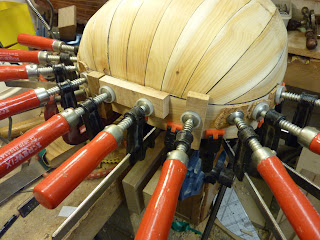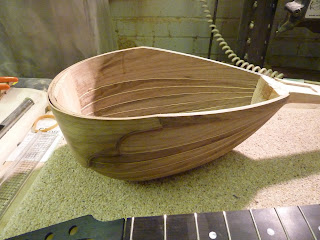The belly is now pretty much completed. The two halves of the tail side of the belly were glued together and this forced the 'cant' angle to set and the belly to stiffen. I glued a reinforcing strip along the underside of the join - I think that this will also help with the accoustic properties of the belly by making it a bit stiffer without adding too much weight.
I used Extramite (formaldehyde urea) glue for this joint.

I tidied up the braces, and added the reinforcement piece at the neck end of the belly. I assume that this is to help support the fretboard, and I don't think that the belly here will add much to the sound.
Before the braces were cut to length I marked the position of the notches cut into bowl (three on each side and one at the tail end to accommodate the reinforcing strip.
Two of the side notches are shown in the third photo.
The final job for the day was lining the bowl with paper. As I understand it, this will help reinforce the rib joints, and will also make the inside of the instrument look a bit neater!
I puzzled over the choice of paper and glue, and asked Dave Hynd for a bit of advice. Dave has a fantastic website:
Mandolin Luthier, with lots of really useful information.
He was very helpful, and I ended up using brown parcel paper and PVA glue (diluted a little with water).

The moisture in the glue might cause the ribs to shift a bit, but a couple of passes with a fine cabinet scraper should fix this when everything is stuck together and dry. I will probably apply a coat of clear varnish over the paper after I have stuck the label in.
 I was going to crack on with this immediately, but I learnt from my lute book that shape of the belly has to be taken while the body is still in the mould. Once it's out of the mould, the body 'relaxes' and ends up longer and thinner!
I was going to crack on with this immediately, but I learnt from my lute book that shape of the belly has to be taken while the body is still in the mould. Once it's out of the mould, the body 'relaxes' and ends up longer and thinner!













.jpg)






























